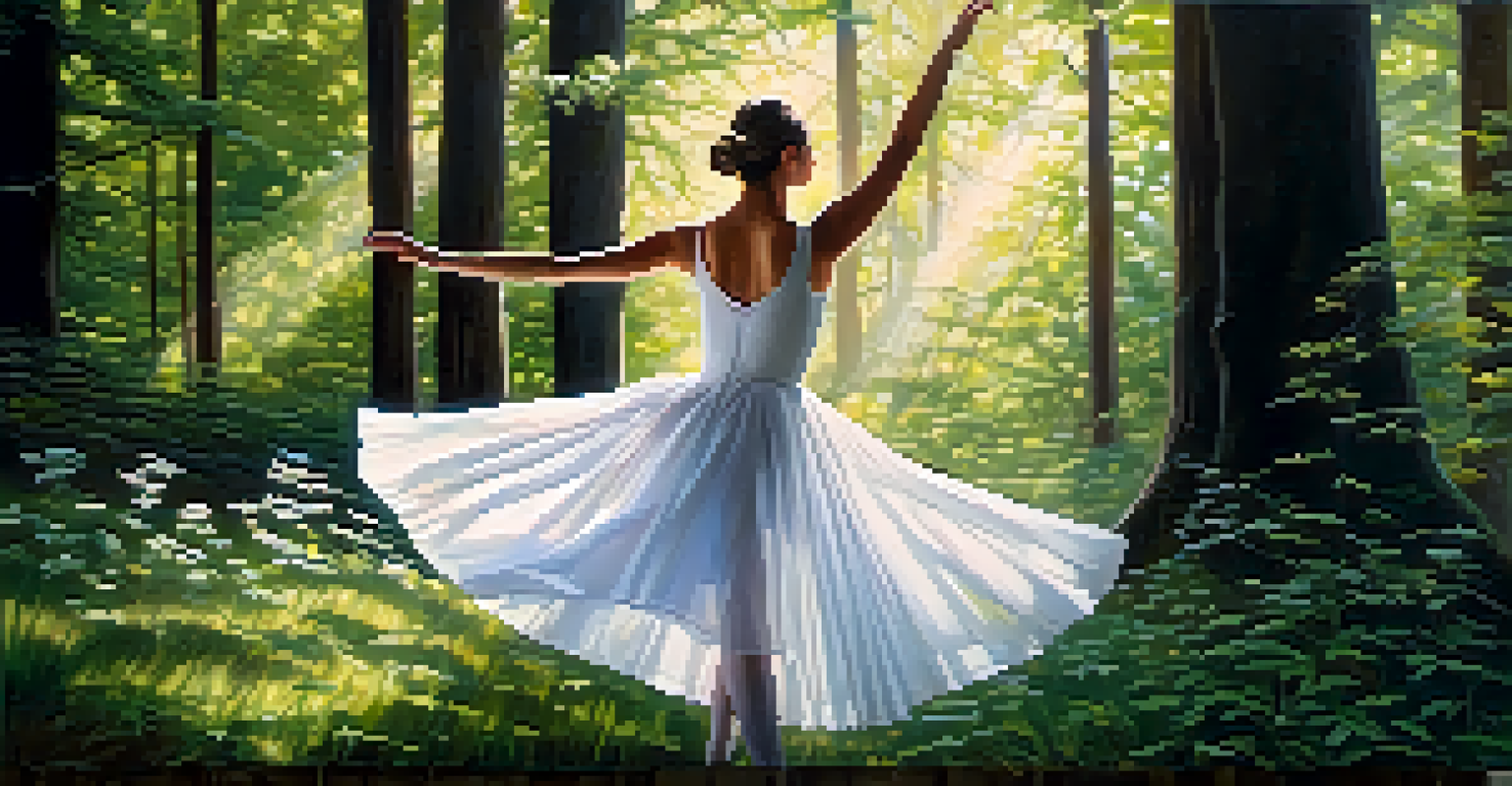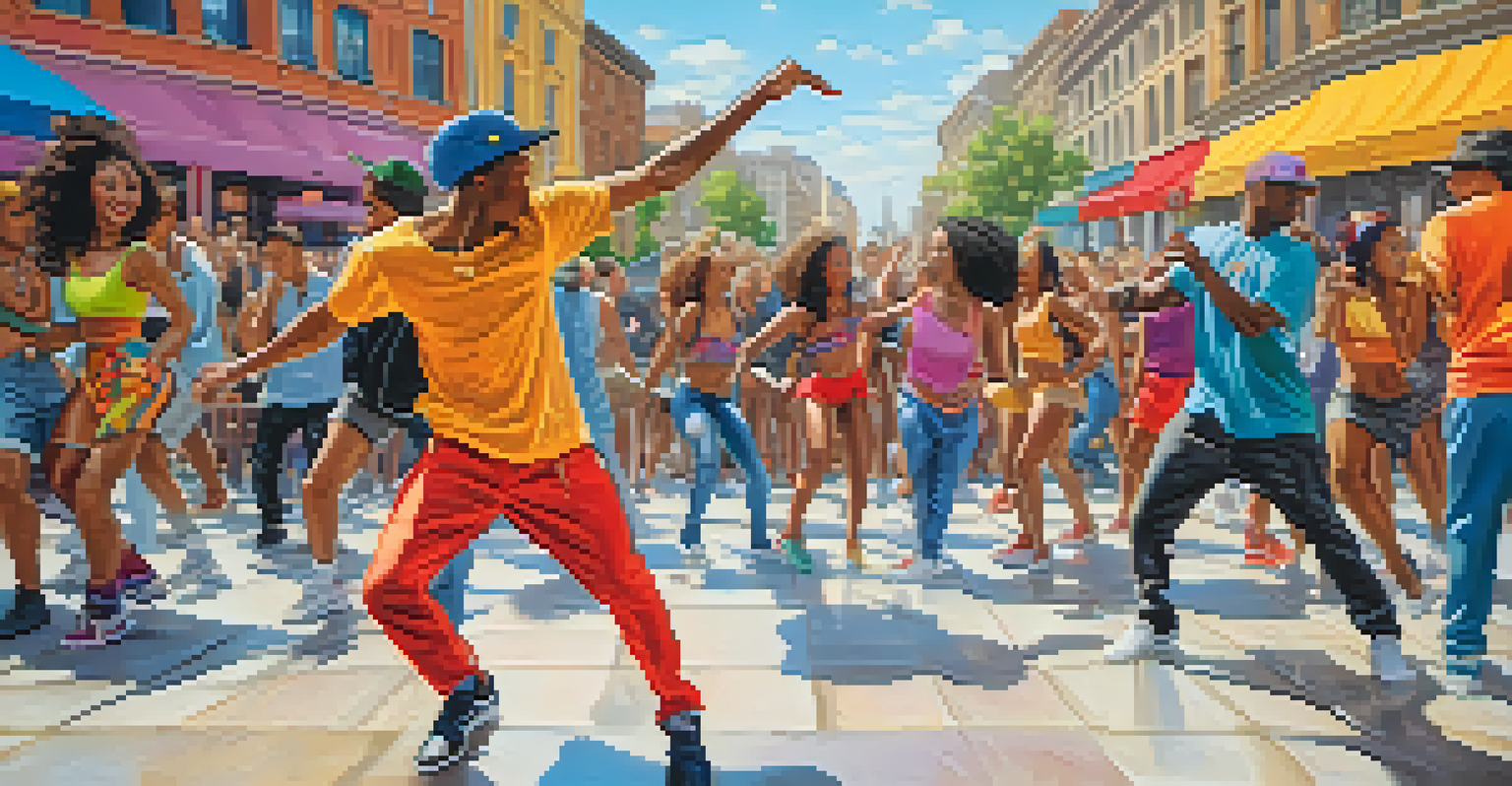Cinematic Dance: Bridging the Gap Between Music and Film

Understanding Cinematic Dance and Its Origins
Cinematic dance is a unique art form that blends movement with storytelling through music and film. Originating from various dance styles, it incorporates elements of ballet, contemporary, and even street dance, allowing for a rich tapestry of expression. This genre has evolved over the decades, influenced by iconic films and choreographers who pushed the boundaries of performance art.
Dance is the hidden language of the soul.
One of the earliest examples of cinematic dance can be traced back to the golden age of Hollywood, where musicals like 'Singin' in the Rain' showcased the power of dance in storytelling. The seamless integration of choreography with plot made these films memorable, establishing a blueprint for future productions. As technology advanced, so did the complexity and creativity of dance sequences in cinema.
Today, cinematic dance continues to flourish, with filmmakers and choreographers collaborating to create visually stunning pieces. This dynamic relationship not only enhances the narrative but also engages audiences on a deeper emotional level, making it a vital component of contemporary filmmaking.
The Emotional Connection of Dance and Music
At its core, cinematic dance thrives on the emotional synergy between music and movement. Music sets the tone, evoking feelings that dancers express through their bodies, creating a powerful connection with the audience. Think of a scene where a character dances joyfully to an upbeat track; the energy is palpable, and viewers can’t help but feel uplifted.

On the flip side, slower, more melancholic music can evoke feelings of sadness or nostalgia, which can be beautifully illustrated through dance. For instance, a contemporary piece may feature fluid, sweeping movements that mirror the haunting melodies of a poignant score. This interplay between the auditory and visual elements creates a rich emotional landscape.
Cinematic Dance Blends Art and Story
Cinematic dance uniquely combines movement and storytelling, drawing from various dance styles to enhance film narratives.
Moreover, choreographers often choose music that resonates with the themes of their films, further deepening the connection. This careful selection ensures that every movement has a purpose, allowing the audience to immerse themselves fully in the experience. The result is a captivating fusion of art that lingers long after the credits roll.
Iconic Films That Showcase Cinematic Dance
There are numerous films that exemplify the power of cinematic dance, each contributing to the genre's evolution. Classics like 'West Side Story' and 'Chicago' are prime examples, where dance not only enhances the storyline but also serves as a character in its own right. These films showcase how choreography can convey complex emotions and relationships.
The dance is a poem of which each movement is a word.
More recent films, such as 'La La Land,' have revived the musical genre, incorporating modern styles and innovative choreography. The dance sequences in these films are meticulously crafted, often intertwining with the narrative to create a cohesive story. Viewers are treated to breathtaking visuals and an unforgettable soundtrack that stays with them long after they leave the theater.
Documentaries like 'Pina,' directed by Wim Wenders, also highlight the significance of dance in film. By showcasing the works of choreographer Pina Bausch, the film illustrates how dance can transcend language and culture, connecting people through shared experiences and emotions. This reinforces the idea that cinematic dance is a universal language.
The Role of Choreography in Film Productions
Choreography is the backbone of cinematic dance, and its role in film productions cannot be overstated. A skilled choreographer crafts sequences that not only look stunning but also serve the narrative. They collaborate closely with directors to ensure that each movement complements the story, enhancing the overall impact of the film.
In many cases, choreographers must think outside the box, using innovative techniques and styles to create memorable sequences. This could mean incorporating elements of acrobatics, traditional dance forms, or even contemporary styles like hip-hop to appeal to diverse audiences. The result is a fresh perspective on storytelling that captivates viewers.
Music Fuels Emotional Dance Connection
The synergy between music and dance creates powerful emotional connections, allowing dancers to express feelings that resonate with audiences.
Moreover, rehearsals are crucial for achieving the perfect execution of choreography on screen. Dancers must not only master their movements but also synchronize with the music and each other. This intensive preparation culminates in performances that are both visually stunning and emotionally resonant, reflecting the dedication of the entire production team.
The Impact of Technology on Cinematic Dance
Technology has dramatically transformed the landscape of cinematic dance, offering new tools and techniques for filmmakers and choreographers. From advanced camera angles to CGI effects, the possibilities for creative expression are virtually limitless. This allows for a more immersive experience, drawing viewers deeper into the narrative.
For example, films like 'In the Heights' utilize drone shots and vibrant color palettes to elevate the dance sequences, making them feel like a celebration of culture and community. These technological advancements enhance the choreography, allowing for dynamic movements that might not have been possible in the past. The result is a visually stunning spectacle that captures the audience's imagination.
Additionally, technology plays a role in post-production, where editing can enhance the rhythm and flow of dance sequences. By manipulating timing and transitions, editors can create a seamless blend of music and movement that feels organic and cohesive. This fusion of technology and artistry has redefined what we can expect from cinematic dance.
Cinematic Dance in Popular Culture Today
Cinematic dance has found a significant place in popular culture, influencing everything from television shows to music videos. Programs like 'So You Think You Can Dance' and 'Dancing with the Stars' celebrate the art of dance, showcasing diverse styles and talents. These platforms have introduced a new generation to the beauty of choreography as a storytelling medium.
Music videos have also embraced cinematic dance, with artists collaborating with renowned choreographers to create visually stunning pieces that capture the essence of their songs. For instance, Beyoncé's 'Single Ladies' is not just a catchy tune; the choreography is iconic and has left a lasting cultural impact. This demonstrates how dance can elevate a music release to new heights.
Future Innovations in Dance and Film
Advancements in technology and streaming platforms are poised to revolutionize cinematic dance, offering new opportunities for creativity and audience engagement.
Moreover, social media platforms like TikTok have allowed dance to reach an even broader audience, fostering a community of creators who share their interpretations of popular choreography. This democratization of dance encourages creativity and experimentation, ensuring that cinematic dance continues to evolve and adapt to the times.
The Future of Cinematic Dance
As we look to the future, the landscape of cinematic dance continues to evolve, driven by innovation and creativity. With the rise of streaming platforms, filmmakers have more opportunities than ever to explore new narratives and styles. This diversification is likely to lead to even more unique and groundbreaking dance sequences in future productions.
Furthermore, the integration of virtual and augmented reality technologies could reshape how audiences experience dance in film. Imagine being able to step into the world of a film and experience the choreography up close, immersing yourself in the performance. This could open up new avenues for storytelling and artistic expression.

Ultimately, the future of cinematic dance lies in its ability to adapt and resonate with audiences. As filmmakers and choreographers continue to push boundaries, we can expect to see more captivating and innovative works that bridge the gap between music and film, creating unforgettable experiences for all.